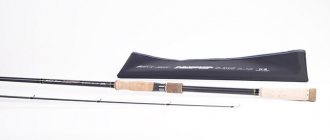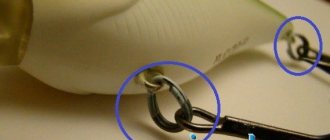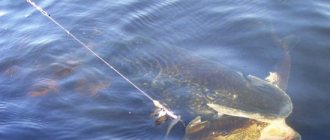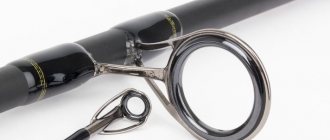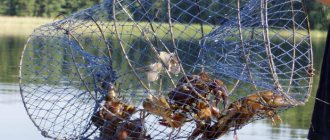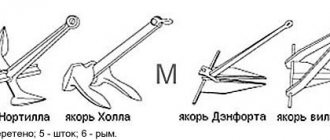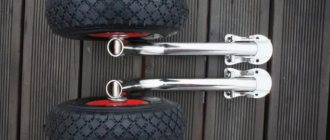What is an anchor eye
The second name for this device is anchor roller. It is needed to securely fix the halyard of a lowered or raised anchor.
The device is designed in such a way that fixation is carried out instantly and holds the mount more than reliably. You can also easily remove the rope from the fastening.
If you have previously fished without a hook, you will highly appreciate this device, since your hands are quickly freed, and you do not have to tie a rope with ten knots and then untangle them.
Anchor knot: how to knit?
To avoid misunderstanding among readers, step-by-step instructions without the use of marine terminology will be presented below:
- Wrap the rope twice around the object. Do the second carry without tightening, otherwise the rope will not fit under it.
- Lower the running end of the rope over the stationary one, pass it under the loose loop, and tighten slightly.
- Wrap the remaining section around the main part of the cable. Insert it into the resulting loop.
- Secure the free end to the fixed end with a tie or wire for additional security.
This is interesting: Determining azimuth using a compass on the ground

As previously mentioned, the anchor knot is extremely similar to another one, the name of which is a simple bayonet with a hose. People not involved in the shipping industry usually confuse them. And this is not surprising. However, it is worth remembering: when performing serious work, this unit is much better suited.
Additional half-bayonets (actions described in paragraphs 2 and 3) make it safer. And if the knot with which the anchor is confused was actually used to fasten any parts of the ship, it would quickly receive new modifications. Otherwise, he could not be trusted with cables with strong traction.
Types of anchor eye
The fairly simple design of the anchor eye has several modifications, which go by the following names:
A handle-eye and an eye-ring for PVC boats are the simplest of the options, and the modification in the form of a handle is well suited for carrying an inflated boat, if necessary.
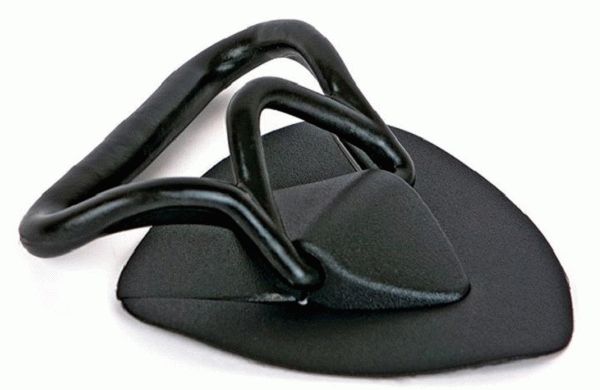
There are other shapes, such as the Badger bow anchor eye.
Where to install
You can often find boats with an already installed eye, which is very convenient, since the manufacturer will firmly attach this device and accurately calculate the correct position for it.
But if the boat is not equipped with this device, and you really want to simplify the process of raising and lowering the anchor, you can secure it with your own hands.
Usually the anchor eye is installed on the bow of the boat, it is called the bow. You should choose a place where the rope will not have any points of contact with the boat, or to be extra sure, buy a special anchor roller and glue it where the rope rubs the fabric of the boat.
Experienced fishermen often advise buying two devices and installing them in convenient places. This installation option is used for large boats.
How to properly install an anchor eye on a PVC boat
The conversation about installation rules should begin by considering the design of any eye:
- The largest in area and most in contact with the surface of the boat is the base; it has the shape of a platform made of hard PVC. This plate will hold the weight of not only the structure, but also, distributing the load, the weight of the anchor and its halyard.
- Shoe lock. It is this part of the eye that serves as a rope clamp. Depending on the connector between the teeth, you can choose the parameters of the rope, or rather, on the contrary - the anchor eye is bought for the already known cross-section of the halyard for the anchor.
- In some designs, a roller for lowering the rope is placed on the plate, or bulges are simply made that guide the halyard in the desired direction, playing the role of a barrier, a side protecting the boat from the slipping rope.
The installation itself is very simple and consists of gluing the eyelet to the side of the boat. Prepare the necessary materials and tools. To attach the eyelet, you will need:
- Polyurethane glue or any other for PVC surfaces.
- Hairdryer, any.
- Pump, pump up the boat.
- Pencil or marker.
- Acetone or other solvent.
- Rope.
- Loads.
- Cylindrical roller for rolling the eye for better adhesion.
- Rym.
Subsequence
- Before work, the boat will need to be pumped up.
- Heat the elastic base of the eye structure in front of a hairdryer and let it cool slightly.
- Place the eye plate on the surface of the boat in the place where it will be attached, bend it to the shape of the cylinder and trace the outline with a pencil or marker (this is necessary to mark the place where the glue should be applied).
- Degrease the surface of the boat inside the contour and the surface of the eye plate.
- Apply a thin layer of glue to both surfaces.
- After 15 minutes, spread the surfaces with a second layer of glue and leave them for another 5-7 minutes to harden.
- Gently press the eye against the boat's cylinder without going beyond the marked outline.
- Make sure that the plate is applied evenly and there are no bubbles between the surfaces, press the eye and roll it with a prepared cylindrical roller or a similar object at hand to seal the joint.
- Press the eyelet onto the boat with the prepared rope and two weights, leave the boat alone until it is completely polymerized (from 5 to 24 hours).
If desired, you can simultaneously glue the anchor roller if the design of the eye does not include it in the kit. The roller is needed so that the rope does not rub the boat's cylinder.
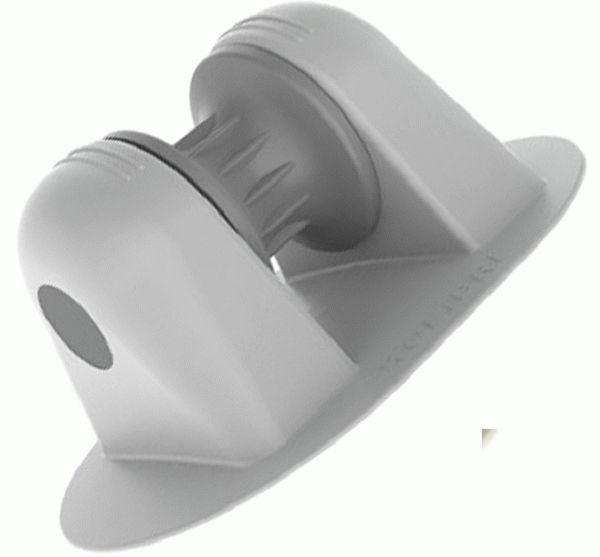
You can also purchase special coins in advance that will allow you to install many useful accessories for the boat - a fishing rod stand, a small table.
Non-snacking anchor for PVC boat
Often, while fishing, the anchor gets caught; the reason for this may be a rocky bottom, or because of snags.
In order to unhook the anchor, there are two ways:
In case swimming is carried out in places where the arms of the anchor may converge, it is necessary to tie another cable using a float (rubber ball, polystyrene foam). If the anchor gets caught too much (happens often), the rope will serve as a safety rope, thanks to which you can easily pull out the caught anchor.
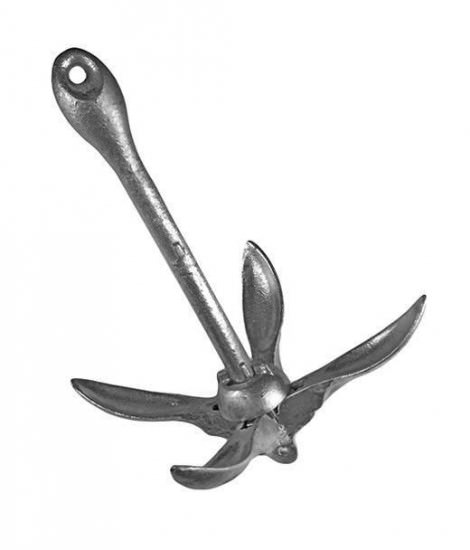
Prices for anchor eye
Depending on the modification and technical indicators, the eyelet can cost from 300 rubles to 8,000. This variation is due to the complexity and equipment of the model, a large number of manufacturers, the region, sometimes even the color of the material from which the eyelet is made can determine the cost of the product.
You should choose from the price category that is more affordable, because high-quality things can be inexpensive.
The lack of space in a small boat is very noticeable, but if you look at it, all the things inside are necessary. You can free up space in the boat by removing the anchor overboard, securing it with a very useful device—an anchor eye.
A wide range of options, colors and prices will allow you to choose the right solution. Fish with pleasure and comfort!
Folk sign: A strong wind during rain means good weather!
How to anchor a boat
Incorrect placement of an inflatable boat can ruin the entire fishing trip, and instead of active recreation, you can end up in a bad mood and disappointment with the fishing process. If you anchor incorrectly, you may end up with a real “bump,” which will throw a light boat in different directions, depending on the direction of the waves and gusts of wind. To avoid such troubles and ensure that the process of fishing from a boat brings only pleasure, it is necessary to anchor the boat correctly.
Putting the boat on guy ropes is quite simple. In order for the boat to stand in any acceptable wave and wind, it is necessary to select the right loads, not too heavy and not too light. For example, for a common inflatable PVC boat about 3 meters long, with a side height of about 40 cm, loads from 12 to 15 kg are suitable. If the bottom is muddy, then the load can be reduced by 10-20%, but on a sandy bottom with a strong wind, such a load can pull off. To install the boat, you must have two identical weights.
Installation on guy wires
The method of securing a boat to guy ropes is to construct a geometric trapezoidal figure. In this case, the boat is parallel to the bottom, and the ropes go to the loads. The ropes from the boat are stretched and arranged in a line, the boat does not turn around, and the incoming load on the cargo is distributed evenly when a wave or wind hits the side of the boat. And even if the boat is hit by strong enough shock waves, the load will still be the same on both weights, and it becomes very difficult to pull it off the weights.
To set the boat up, you need to determine the direction of the wind, or even better, look at the weather forecast in advance, check the speed and direction of the wind during the time allotted for fishing. Quite often, in the morning there may be one wind direction, and in the afternoon or evening another. With this information, it will be much easier to navigate around, and much easier to figure out how to properly anchor the boat in the direction of the wind.
After arriving at the fishing spot, you need to complete a number of steps to install and stretch the inflatable boat:
- Set the boat perpendicular to the wind and sail from the desired fishing spot at a distance of 5-6 meters (depending on the depth) and drop the first load with a long rope to the bottom.
- Next, float the boat perpendicular to the wind, using the entire remaining rope and pull it, tug the rope a little 2-3 times so that the load silts up and holds well to the bottom. The wind should also hit the side.
- Drop the second load so that the first rope is not tight, but with some slack.
- Now, taking hold of the first long rope, pull the boat, which will begin to move backward. As soon as you realize that the boat has stalled, attach a long cord to the boat.
You need to fish from the back side of the board in the stern part in the direction of the wind. The wind should blow to the side and to the back, and the load will be distributed equally to both ropes and weights at the same time. This design allows the boat to stand in a stretch and be securely anchored. With this setup, both weights will be at the same distance from the boat and will not interfere with fishing from the side.
If algae protruding to the surface grows abundantly at the place where the boat is placed, long ropes are not necessary. It is enough to lower them vertically down. The algae will become entangled in the ropes of the load and will not allow it to move even in strong winds.
How to unmoor a boat
The long rope that has been wound out must be thrown back from the boat back into the water. Then pull out a short rope, pulling it and the load into the boat. Then we move to the bow of the boat and pull out the second load.
How it works
You need to tie a cable behind the trend and pass it through the pin, which is located in the hole at the end of the trend. If necessary, when the anchor is hooked, the cable must be pulled in the opposite direction of the spindle, and the pin will break, thereby releasing the anchor.
There is a method for attaching a pin, with which you can pull the cable in any direction, not necessarily the opposite direction of the spindle, only with great effort. To do this, you need to secure the pin not to the trend, but to the cable. A rope (cable) is also attached to the cable, which will be closed to the trend and form a loop.
As a check, you can use wire and fishing line bent into a circle, and a polymer clamp, which can be easily purchased at any construction supply store, is also perfect. Also note that you can use not just one pin, but several at once, and thereby the breaking force will increase.
You need to know that there are two types of check installation, each of them has its own breaking force:
- The sliding installation requires a sharp boost, if you pull smoothly, the boat will end up in the wrong direction at that time. The breaking load of a sliding installation is 10–15 kg, no more.
- Fixed installation. With this installation, the pin should not be destroyed by the force of the vessel's demolition. To break the pin, a breaking force of 30–40 kg is required. You can destroy a pin with such breaking force using an outboard motor. The pushing force of the motor at full speed is 2.5 hp. is 50 kg. Both methods are good, however, the best method remains the cable with a float (Buirep).
Once again about anchors
Once again about anchors
Once again about anchors
When equipping a fishing boat, special attention should be paid to the selection and installation of anchors. Navigation textbooks say: “The anchor device is used to hold the vessel in place while moored away from the shore, as well as near an unequipped shore.” But you never know what other situations will arise when the ship will not even need to be held, but simply oriented with the wind or wave.
The main characteristic of any anchor is its holding force. It depends on several parameters, but the main one by which selection is made for a particular boat is the mass of the anchor. There are complex formulas for calculating it - taking into account the main dimensions of the vessel, the dimensions of its superstructures (keeping in mind their windage when exposed to wind), the cross-sectional area of the immersed part at midship, etc. There are simpler formulas - for example, this one: P = 10× 3√ D2: k, where P is the mass of the anchor, kg; D is the total displacement of the vessel, t; k is the anchor holding force coefficient, depending on its design (for the Admiralty anchor - 1, for the Hall anchor - 2). In my personal practice, I use a completely simplified calculation: for a vessel with a displacement of about 1000 kg, the anchor is about 7-10 kg, and for a boat with a displacement of 500 kg, respectively, 4-5 kg, and this directly proportional relationship remains for all displacement values.
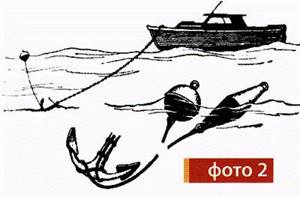
Often you have to have several anchors of different designs at your disposal - and take them on board depending on the places of the upcoming fishing trips. In maritime affairs there is a term “anchors of a recognized type”. These include quite a lot of different models, but we will focus only on a few that are most suitable for small and pleasure boats.
These include:
- Admiralty folding anchor (photo 1) - as the most adapted to all types of soil, although not with the greatest holding force - because, unlike other other designs (say, Matrosov, Hall) it clings to the bottom not with two, but with only one paw . Models weighing 5, 10 and 12 kg are designed for amateur fishing boats; they can be installed on vessels with a displacement of even more than 1000 kg. The design of such anchors involves releasing them manually. The anchor can be installed using a buoy on a buoy rope, marking the position of the anchor (photo 2). And if the anchor is stuck and you can’t lift it by the anchor rope, just pull the buoy rope to free it. By the way, you can use a piece of polystyrene foam or an empty plastic bottle as a buffer.
- Danforth Anchor - photo 3 - increased holding power on most soils. On sale you can find models weighing 4, 6, 8 and 10 kg. The disadvantages include large overall dimensions. Also more designed for manual recoil. Can be installed on ships with a displacement of just over 1000 kg.
- Bruce's rodless anchor (Bruce Anchor - photo 4) is also an anchor with increased holding force, and shows especially good results on soft soils. The most common models are 5, 7.5, 10, 15, 20 and 30 kg. Due to its geometry, it is better suited for placement on large boats with a displacement of over 3000 kg, equipped with an electromechanical anchor winch. Setting up such an anchor requires the presence of a buoy.
- Attwood Anchor (photo 5) is another example of anchors with increased holding power. Usually in stores you will find their models weighing 4, 5 and 7 kg. It has quite large dimensions, because... the anchor is not foldable. It can be installed on ships with a displacement of up to 800 kg. The release of such an anchor is usually carried out manually.
- Recognized anchor types also include Matrosov anchors (photo 6), Hall anchors (photo 7) and plow anchors (photo 8), but these models are less commonly found on the shelves of specialized stores - they are larger in size, which is not always convenient on small boats.
We cannot ignore another category of anchors, which, although it does not belong to the concept of “recognized type,” still has the right to exist: in the small fleet, the folding cat anchor is most widespread (photo 9). In terms of its design features, this anchor turns out to be the most compact and can well be considered as a verp, i.e. auxiliary (due to its relatively small holding force) for large ships. The anchor is suitable for almost any soil. On store shelves it is found in the widest range - weighing from 1.5 to 12 kg with a step-by-step increase of 0.5 kg.
Choosing Anchor Rope
Ropes made of artificial materials have undoubted advantages: they are not subject to rotting, almost do not lose their characteristics when exposed to water and sunlight, they have noticeably higher strength characteristics, which makes it possible to use an anchor cable of a smaller cross-section. There is a fairly large selection of synthetics on the market in a wide range of colors, diameters, breaking loads and types of weaving.
Synthetic cables with a diameter of 7 mm and above have a breaking force of more than 1000 kg. Based on the premise that the numerical value of the breaking force of the anchor rope should exceed the mass of the anchor by 50 - 70 times, we obtain the possibility of using cables with a diameter of 7 - 10 mm on ships with a displacement of about a ton with anchors of 10 - 15 kg. And although for ships of smaller displacement all parameters decrease proportionally, nevertheless, recommendations for cable diameters start from 7 - 7.5 mm. It would seem that there is a clear excess of strength, but if you use a small diameter, then when raising the anchor, especially when it comes off the bottom, the thin rope will simply cut your hands.
What type of weaving should I choose? The recommendation will be only general: the rope should not be overly rigid. The practice of using various types of cables shows that most ships where the anchor is lifted manually use a sling as an anchor rope. Slings come in different types and sections. The best option for small vessels would be a sling woven with stocking and having a width of 16 mm.
The length of the anchor rope is selected taking into account the possible navigation area. An increase in length leads to an increase in the holding force of the anchor. However, this will be noticeable only within certain limits. Practice shows that for small vessels it is quite enough to have an anchor cable length ranging from 4 to 6 times the depth under the keel of the vessel at the mooring site. The length may be slightly increased if the sailing area is in areas with strong currents or strong winds. For example, when the wind is force 9 or higher, it is recommended that the length of the rope be at least seven times the depth under the keel.
How to tie a cable to an anchor and an anchor rope to a ship
In most cases, the anchor is tied with a cable behind the eye with a self-tightening knot. A fishing knot like the one in photo 10 works well. The options in photos 11 and 12 are also possible.
If we consider the forces acting on the boat, especially when setting an anchor on a wave, then the most advantageous point of attachment is located as low as possible along the stem (photo 13). And the higher the attachment point, the greater the leverage and, consequently, the force acting relative to the center of gravity of the vessel, which tends to sink the bow. And the lower along the stem we attach the anchor cable, the less chance the boat has of burying itself in the oncoming wave. Similarly, you should choose the location for attaching the towing halyard if we are talking about towing the vessel against the wave. There are only two ways to attach an anchor rope to a boat: using a screw carabiner or a simple knot. The main thing is to ensure a reliable connection.
Increasing anchor holding force
You can increase the holding force of the anchor using a simple device in the form of a piece of large-link chain 70 - 200 cm long. There are several options, but the most effective is this: the chain is attached directly to the anchor eye, and the anchor rope is tied to it (photo 14).

Due to such loading, it is possible to significantly increase the sag of the anchor rope, which will significantly change the direction of the breaking force - and thereby significantly increase the holding capabilities of the anchor.
"Sports fishing No. 8 - 2010"
Kaliningrad Fishing Club” was used as source material
«
Types of anchors
- and two rotatable lamps that dig deep into the ground are ideal There is a method that allows you to increase the holding power against the current; the anchor rope is tied to the front of the boat (bow loop) and lowered into the water as close to the side as possible. Where the current is deep or strong, this method is strictly prohibited, since the long rope may cause the boat to yaw, so it is advisable to use this method in shallow water bodies or in places with weak waves.
- There is an anchor shaped like an inverted mushroom. This anchor is easy to store, which is an advantage in mass ratios as well as size ratios. It is good to use in places where there is silt, clay, and also on the bottom with algae.
- An anchor with a mushroom shape, which has two legs, making it possible to burrow into the bottom with stones and snags.
The drift force depends on the weight of the boat. Two anchors are required to hold a large boat in a strong current. One anchor with lamps is on a long rope, and the second is a mushroom-shaped anchor, which is lowered onto another rope. The second anchor is used to prevent the boat from dangling so much.
- A ship anchor weighing 7 kg on a long rope can support a small ship in any weather. This type of anchor is well suited for fishing from a small boat. Such anchors are good to use on a soft bottom; they are not afraid of corrosion due to the vinyl coating; moreover, such a coating helps to avoid damage to the vessel when pulling out the anchor.
- Danforth anchor with special claws, with the help of which it is possible to use this design even in muddy areas. Often, such anchors are required for large boats, since the anchor itself of this model has a large mass and is also rather large in size.
Anchor: types, choosing one suitable for boats/small craft, nuances, making it yourself
Owners of small watercraft are encouraged to make an anchor with their own hands not only by the fairly high price of factory anchors. Standard anchors are produced weighing from 5 kg, which is a bit much for a boat with a displacement of up to 500 kg. Especially if they go out into a closed, calm water area (pond, small lake, river). The anchor alone takes up a lot of space in the vessel, and in a tiny boat, such as, for example, a dinghy or skiff, which is popular due to its high qualities, it is inconvenient to hold an unreasonably large anchor. But you can’t stand on just anything instead of a reliable anchor.
It was not for nothing that Joseph Conrad called anchors “honest pieces of iron”: neglecting the reliability of an anchor can cost the life of the boatmaster and passengers even close to the shore. A homemade anchor should hold the ship as firmly as a proprietary branded one, and should not get lost in the ground more often than it does. The reliability of commercially available ultra-light anchors is not guaranteed. Do not trust company certificates: no marine or river register will include an anchor weighing less than 5 kg in its register. Prohibited by international navigation safety regulations. And they, like army regulations, are written in human lives.
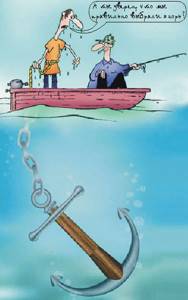
Fishing boat at anchor. Caricature
A real tangle of problems is the PVC boat anchor. Firstly, the anchor is only part of the anchor device, consisting of several structural units. Each of them, according to the main rule of strength of strength, “Where it is thin, it breaks,” must be no less reliable than the anchor itself. There is simply nowhere to place all this in an inflatable boat. Secondly, when inflatable boats in the budget price category began to be made not from rubber or rubberized fabric, but from plastic, it turned out that a raised anchor in such a boat could be dangerous - the number of accidents on the water caused by the rupture of the cylinder or the bottom of the boat by the anchor, has increased sharply.
The purpose of this article is to help a novice boatmaster solve the problem of choosing a prototype anchor for his vessel and tell him how to properly make an anchor in accordance with the type of vessel design, its displacement and sailing conditions. A significant part of the material is devoted to the choice and features of the manufacture of anchors for “ultra-small” vessels (up to 0.5 tons) operating on inland waters. The bottom in them is often marshy, muddy or peaty; in such a situation it is difficult both to ensure the proper holding force of the anchor and to prevent it from sinking into the ground.
Note: all inflatable boats have one more difference from normal displacement vessels - very low frictional resistance against the water. An inflatable boat clings to the water less strongly than a glider. On the one hand, this is good for calm water, since it is easier to keep the boat in the current. But in excitement, on the contrary, it is more difficult, because... the float boat tugs hard on the anchor rope. And anchoring an inflatable boat is also more difficult: he cannot rely on the vessel to pull him, lay him down properly on the ground and help him cling to him. Here, the anchor for an inflatable boat must rely only on itself: it should be laid correctly without a jerk from the vessel and have absolute tenacity (see below).
Basic requirements for anchors for PVC boats
- Regardless of the weather, the main task of the anchor is to reliably hold the boat (vessel) both in strong winds and in strong currents. The oncoming waves create jerks on the vessel; the anchor should not move when exposed to jerks.
- A snagged anchor should be easy to remove. Losing an anchor at the wrong time can be a real disaster for fishermen, so the anchor must be easily removed from snags.
- The mass of the anchor should be less. An anchor weighing 2.5 kg has the ability to hold several times more than an object weighing 10 kg.
- Must be sustainable. It is desirable that the anchor be painted or made of stainless alloys. Over time, rusty deposits will form on the anchor, which causes dirty things and short life.
Is the cat an anchor?
To people who go fishing on an old rubber boat, all these considerations may seem far-fetched: of course, it is known that the long-established anchor for a rubber boat is a cat. And it’s not difficult to make: three pieces of reinforcement, two of which have flattened ends, a little bending, a little welding, and the cat is ready. And the tenacity of a cat is absolute if thrown correctly. It is not without reason that hook cats are used in other activities.
Firstly, in terms of holding power, the cat anchor is quite average. True, for a boat that glides through the water almost like a fallen leaf, this is not so significant. Another significant thing is that it is very easy to lose a cat on rocky or muddy ground. When scrap metal was lying everywhere underfoot, and the master at work and without a bottle allowed him to use welding and a bending machine for personal purposes, it didn’t matter, but now are different times.
Secondly, even then there were plenty of accidents on the water due to grapple anchors. And now it has turned out that a cat is dangerous not only in a PVC boat, but also in one made of plywood without a hull, like the same dinghies or skiffs. Molded folding crampons are safe, hold an ultra-small boat well on any ground, are compact, but are unfairly expensive. Although for a sewn boat with a rigid hull approx. A 2.5-3.5 m long homemade folding cat with a swivel paw is also suitable, see for example. video
